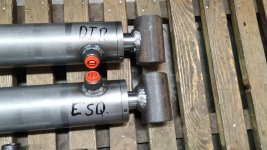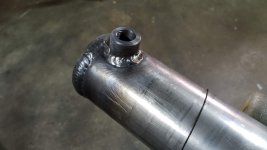Sebculb
Gold Member
Hola everyone,
Today I dropped a big rock on the chromed stanchion rod of the stabilizer foot on my backhoe and it broke. Sheared right off. Really should be more careful.
Can I Weld this with satisfactory results? My backhoe mechanic (who has repeatedly made it clear that I should always take his advice unquestioningly with the credibility of a cult leader) says it's not a good idea. I'm stubborn and a pretty decent welder so I'm inclined to try it anyway.
It's broken pretty close to the end of the rod's run, next to the cylinder and where all the seals are. I'd have to disassemble it and remove the seals to keep them from getting cooked.
I'd bevel top and bottom sides of both pieces to the center. Perhaps even do it with a chop saw at 45'.. Then clamp it in a piece of angle iron and start filling it in with metal. 7018? Stainless? Thin 6013 in the center for the first pass just to get it stuck? Let it cool completely between passes? This is just my idle conjecture. Then I'd take it to a shop to have it turned round again
Reading online I saw someone else who was a machinist say they usually bore out both pieces 3/4 of the thickness, thread it, insert a hardened threaded stud and Weld the last bit around. This sounds good except that 3/4 of the rod is hollow where the internal stud starts and finishes. Seems like it could shear off. If a Weld turns out "good", it seems like it'd be sturdier to me.
But I'm just a jackass with a stick welder, what do I know.
It's an 8 ton 4wd deere backhoe that works stupid hard so it's gotta be good. My mechanic says if the fix breaks inside the cylinder I'll have an even more expensive problem.
Any advice? Anyone think this is feasible? Thanks!
Today I dropped a big rock on the chromed stanchion rod of the stabilizer foot on my backhoe and it broke. Sheared right off. Really should be more careful.
Can I Weld this with satisfactory results? My backhoe mechanic (who has repeatedly made it clear that I should always take his advice unquestioningly with the credibility of a cult leader) says it's not a good idea. I'm stubborn and a pretty decent welder so I'm inclined to try it anyway.
It's broken pretty close to the end of the rod's run, next to the cylinder and where all the seals are. I'd have to disassemble it and remove the seals to keep them from getting cooked.
I'd bevel top and bottom sides of both pieces to the center. Perhaps even do it with a chop saw at 45'.. Then clamp it in a piece of angle iron and start filling it in with metal. 7018? Stainless? Thin 6013 in the center for the first pass just to get it stuck? Let it cool completely between passes? This is just my idle conjecture. Then I'd take it to a shop to have it turned round again
Reading online I saw someone else who was a machinist say they usually bore out both pieces 3/4 of the thickness, thread it, insert a hardened threaded stud and Weld the last bit around. This sounds good except that 3/4 of the rod is hollow where the internal stud starts and finishes. Seems like it could shear off. If a Weld turns out "good", it seems like it'd be sturdier to me.
But I'm just a jackass with a stick welder, what do I know.
It's an 8 ton 4wd deere backhoe that works stupid hard so it's gotta be good. My mechanic says if the fix breaks inside the cylinder I'll have an even more expensive problem.
Any advice? Anyone think this is feasible? Thanks!

